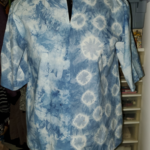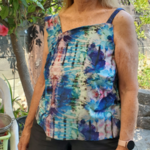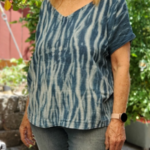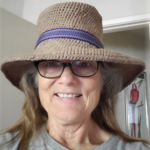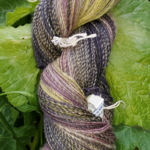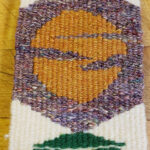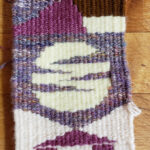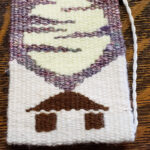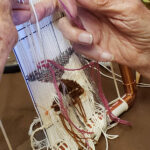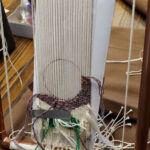The members of the Fiber Artisans Guild are passionate about their commitment to the fiber community–both locally and internationally. We support groups that help artists and fiber workers and are a member of the Conference of Northern California Handweavers.
January 2024 – Madder, Indigo, Pin Looms, and More!
We had a very productive meeting last Sunday.
We learned that if the Indigo Pot gets over 135 F, the indigo starts to solidify and the pot gets a foam on top. Once it cools down to 135 F the pot dyes ok, no harm done. So don’t heat the dye pot over 135 F.
Sandy, Christine, Sharolene, Marcia, and Frank dyed their warps. At this point it sounds like everyone has completed dying their Ikat warps. So, there is no need to do Indigo dyeing for a while.
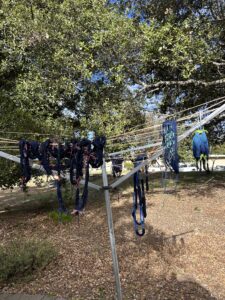
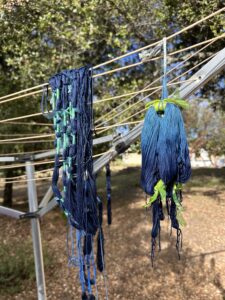
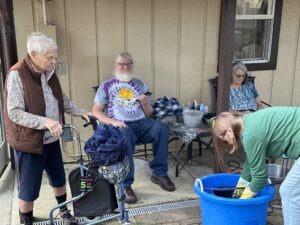
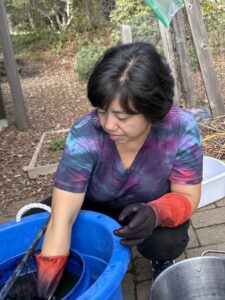
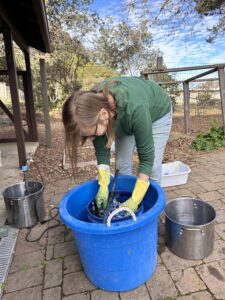
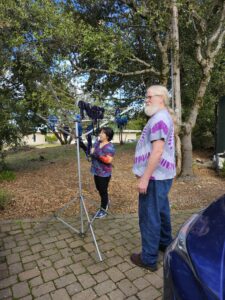
Anne, Sharolene, and Marcia dug madder. There was not enough to use for dye, but Christine and Julie took what was found to plant in their gardens. We had a discussion about processing madder root so it can be used for dyeing. Frank showed us tools that you can use to clean the madder and process it, including a scrub pad, tenderizing tool, and potato peeler.
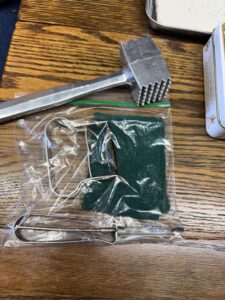
We then talked about the Pin Loom Friendship project. Marcia showed her collection of samples made on pin looms and books on pin loom weaving. Marcia also lent pin looms out to Christine, Julie and Frank. Sandy decided she would buy her own Zoom loom to use. Marcia gave an impromptu demonstration of how to weave on a pin loom. Sharolene showed us a scarf she made out of pin loom squares. She spun all the yarn for the scarf and added a lace knit edging around the scarf.
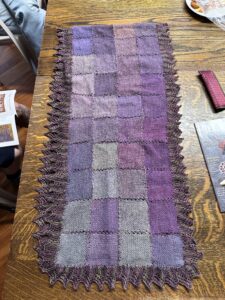
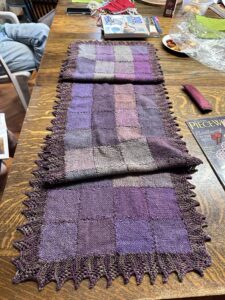
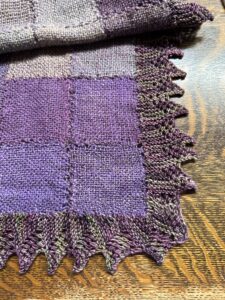
Frank also showed Julie how to make booklets from our handmade paper and showed his handmade fabric booklet cover.
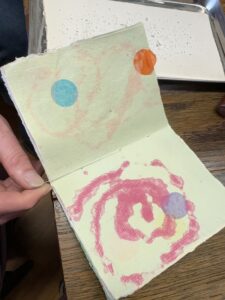

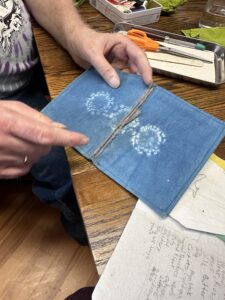
Other show and tell – Marcia and Sharolene showed us their ikat scarves.
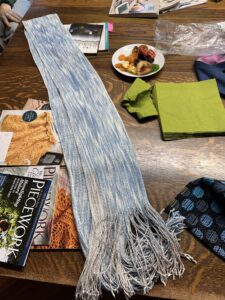
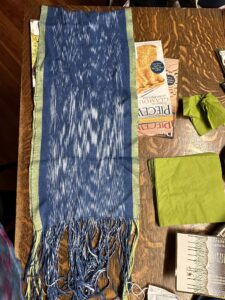
And Sharolene showed us her turned taquete towel.
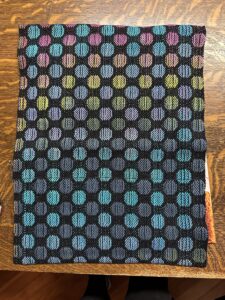
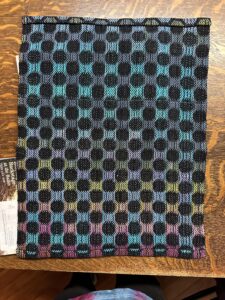
For the pin loom project, we decided:
- We will be using 4 inch pin looms.
- Worsted weight yarn or thinner. Sharolene’s scarf was more of a fingering weight.
- 6 inch needles to weave with.
- We will be weaving plane tabby squares. We will NOT be weaving bias squares.
We then discussed what we wanted to do about our donation for the CHNC auction. We decided to donate a spinning project.
- Anne will donate colored wool she drum carded. She will store the wool until the February meeting.
- Frank will donate a drop spindle and some commercial roving.
- Marcia will donate knitting needles and a knitting pattern.
- Sandy will donate a weaving pattern.
- Marcia will buy tissue paper and ribbon for the Guild to package everything with.
December 2023 – Indigo Dyeing
We met at Anne Dunham’s for Indigo a dye day last Sunday.
It was windy and rainy, so Anne let us set up the dye pot in her studio. The pot dyed great. Sharolene had 3 or 4 warps, Sandy had 2 or 3 warps, and Anne had 5 or 6 skeins of gray wool to dye. So, we set the pot up and then eat lunch. When lunch was done, we started dyeing. We finished dyeing by 3. Anne rinsed her wool and after 3 or 4 rinses the water was clear.
We couldn’t swing the warps or hang them on the fence because of the rain and wind. It didn’t matter though because we took the yarn from the dye pot to a wet pot. The wet pot was where we wrung the excess dye water out. We then put the steaming damp yarn into a dry pot. By the time the yarn made it to the dry pot, it had gotten enough oxygen.
The other thing we learned was it is easier to transport the dye bucket inside the large blue tubs with 2 people, not one person carrying the dye bucket alone.
November 2023 – Indigo Dyeing
From Frank: Sandy and I went to Anne Dunham’s for Indigo dying. We adjusted the ph and added the dye remover. Then we added the bucket heater. We then went in and soaked our warps in hot water. We then eat. When the dye remover was in the pot for 1 hour and the pot was up to 130 F, we removed the heater and started dying. We dipped for 4 minutes mostly. Sandy had 5 small warps and I had 4 small warps. Sandy only dipped twice at most. I dipped some of mine up to 4 times. We got dark blue after 2 4-minute dips.
Working Alone Together
With the new normal imposed by Covid-19 our monthly meetings have been suspended indefinitely. However this does not mean we have been idle. We still communicate with each other. Here are photos of projects from Natalie, Sandy, Sharolene, and Frank.
Here is Natalie’s no-pattern knit cardigan and the beginning of her basket being made from fabric and yarn.


Sandy, our tapestry aficionado, finished her stunning tapestry of a burro. Those of us who have been learning tapestry techniques from Sandy are left speechless.

Sharolene has added three tops and a hat to her wardrobe and has some new yarn to experiment with.
Frank has stunned us by learning to do Irish needle lace and making this memorial piece for his neighbor’s cat out of hand-spindle spun cat fur. It measures 4.5 x 4.5 inches.

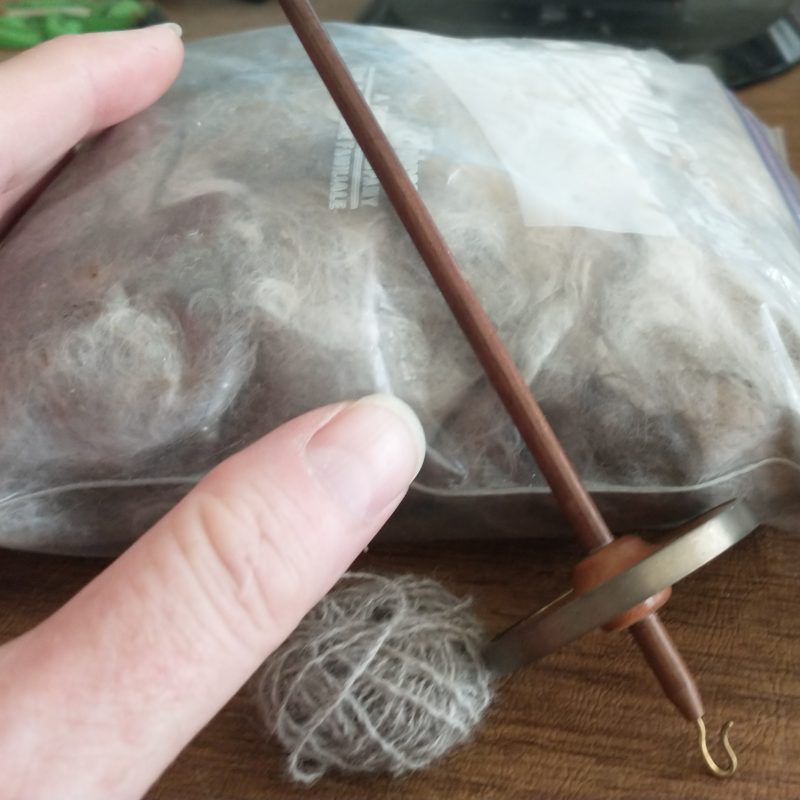
Who knows what the rest of us may be working on! We are eager to get together again to share our love of fiber.
By early October our prolific tapestry weaver, Sandy, finished her tapestry called My Father’s Ghost and is already hatching ideas for her next tapestry.
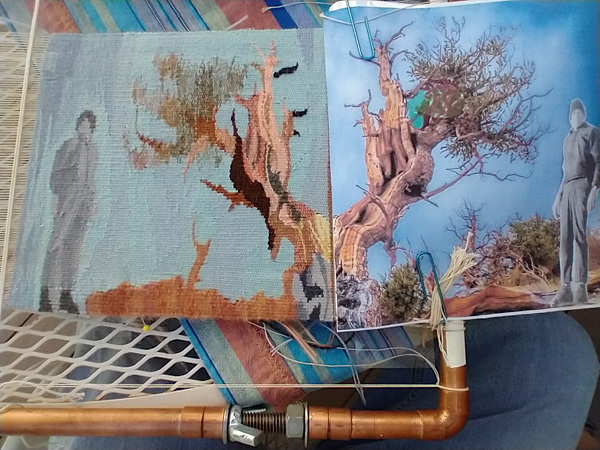
______________________________________________
Frank has caught the tapestry bug fish too. Here is his Fish in a Tin.
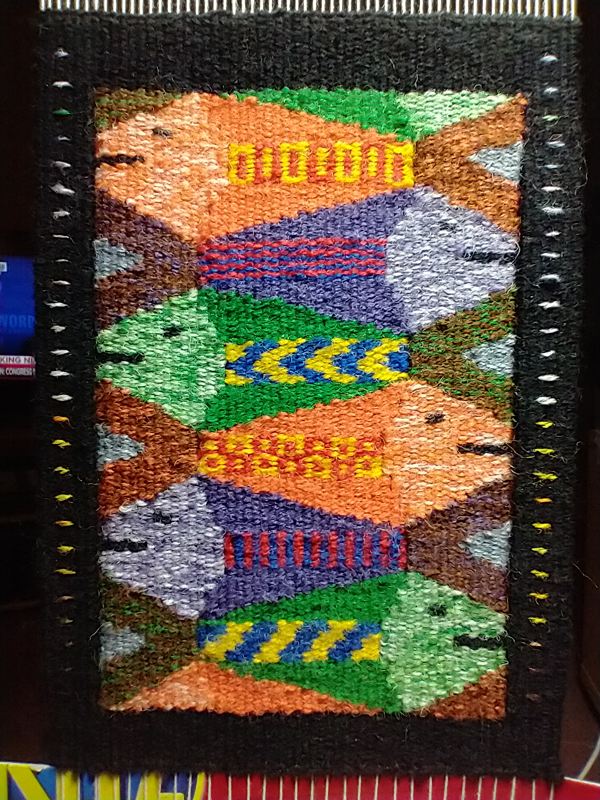
Tapestries! Time for a New Beginning
We have finished our tapestries and learned much. It is time for a new start. We will design our own with more complex shapes and shading and continue our this adventure.
Our Tapestry Samplers
We are continuing the tapestry project we started last January. Every month we learn a little more. This month some of us finished our samples and are looking forward to designing our own tapestries now that we know some of the tricks to making shapes, dyeing our yarn with natural dyes, and starting and finishing our piece. Here is a glimpse of this ongoing project.

Natural Dyes: Our Results
Today we surveyed the results of our recent project and divided our skeins among our members. In recent months we have experimented with indigo, weld, osage orange, cochineal, and walnuts. Here is what we have.

- Weld mordanted with soda ash to adjust the pH and boiled (top, left)
- Osage orange – we found that pH matters (bottom, left)
- Osage orange overdyed with indigo (top, second from left)
- Weld overdyed with indigo (top, third from left)
- Indigo overdyed with walnuts (top, fourth from left)
- Indigo dipped three or four times for two minutes (top, fifth from left)
- Indigo dipped once for two minutes (right end)
- Light indigo overdyed in cochineal afterbath (bottom, right)
- Cochineal mordanted with cream of tartar to adjust the Ph dipped for ten minutes (bottom, second from right)
- Cochineal mordanted with cream of tartar to adjust the Ph dipped for one hour (on reel)
- Cochineal overdyed with black walnuts (lower row, center)
- Indigo overdyed with cochineal (bottom, second from left)
We also put together a goodie basket to be sold at the raffle for the Conference of Northern Califiornia Handweavers (CNCH) conference in 2020. Here is what we have so far.
A lovely day with much accomplished!
Dyeing for Red
For centuries red has been revered–and hard to come by–as a color to dye for. Its scarcity, along with purple, has often made it a color reserved for royalty. But over the centuries some recipes have been developed to achieve a vibrant red. This month we are dyeing some of our wool with cochineal, a red dye developed in South and Central America. This dye was developed from beetles(!) that live on cactus plants. It has been used as the Navajo red made famous in some of the early rugs from the Navajo nation.
The process is not simple. We mordanted our wool. (That means pre-treating it with an oxide solution to help fix the dye so it won’t fade). We had purchased a few ounces of the dried cochineal beetles which we ground in a coffee grinder that we use exclusively for our dyeing. We mixed these powdered beetles with water and simmered the mixture for an hour. We then took our warmed damp mordanted wool skeins and simmered them in the dye bath.
Some of the skeins we had already dyed yellow of blue, so we were overdyeing them to see what colors we might get.


Here is the result of our adventure.

As usual we had a few surprises but were very impressed with our results.
We now have the following tapestry wool for each of the members. The first photo, from left to right, shows wool dyed in weld (top), dyed in osage orange (bottom). The next two skeins are indigo dyed dipped three or four times (top) and dipped one time (bottom). The third set of skeins are the weld and osage orange skeins over-dyed with one dip in indigo and the last two skeins were over-dyed three or four times in indigo.
The second photo is weld over-dyed with cochineal and osage orange over-dyed with cochineal.
The third photo is indigo dipped four times and over-dyed with cochineal.



In 2012 I visited two Zapotec weavers, Jaime and Joey, who lived in the Central Valley. Jaime’s family, originally from Mexico, had been weavers for four generations. Hanging on the front porch were a number of cactus pads, which Jaime’s father had gathered from the desert in Southern California. The cactus was home to cochineal beetles who protect themselves from the desert heat by surrounding themselves with a white “insulation” which they produce somehow.
Jaime crushed one of these “cocoons” to show me the red produced by the beetles, which are dried before being used. (They literally die for dye!)
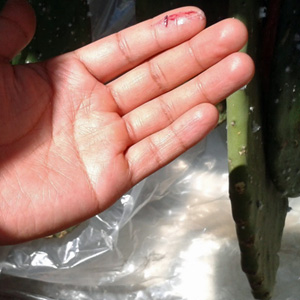
We also were intrigued to see Sharolene’s new tiny spinning “wheel”. This little portable device is an electric spinner that can run off a battery, is speedy and versatile, and makes almost no noise. See more about it here.
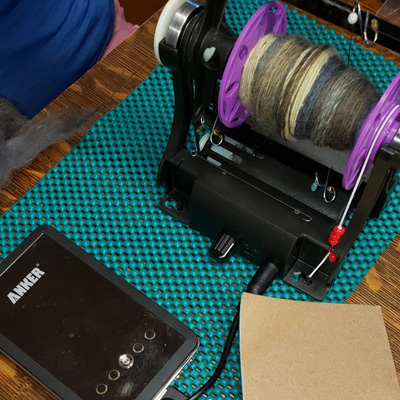
A Blue Sunday
We started our natural dye project in earnest. This will give us colored wool to use in the tapestry project we have started. This month we activated our indigo pot. We have one that we store in a covered pot so as not to waste any of our indigo, We bring the pot out several times a year. Normally we do this outside in the summer. This helps bring the temperature of the pot to an appropriate level by using some sunlight and allows us to do the entire process outdoors. We are dyeing carefully weighed wool skeins that we will continue to use in upcoming months to over-dye with other colors to get a number of colors to use in our tapestries. Some have already been dyed another color and we will overdye them with indigo blue.
The indigo bath must achieve the right pH and the right temperature in order to successfully produce color. We heat it if we need to and add commercial dye remover until we achieve the appropriate pH. We must be careful not to introduce oxygen into the pot which, amazingly, looks like its green, not blue.
When the yarn is removed from the pot, it looks green. But as it gets oxygen from the air it starts turning blue . It’s magic!
But the yarn that had already been dyed yellow turns green!
This is just the beginning! More colors to come.
New Year, New Project
This month everyone came prepared to launch a new tapestry project. Sandy has been doing tapestries for some years and has studied with some of the best instructors. She was prepared to get us all started. This included building our own copper looms from parts she had assembled into a kit for each of us–which even included a handmade carrying pouch that could accommodate the loom and necessary tools.
 When the loom is assembled it can stand upright and has adjustments on the side bars to tighten or loosen the warp.
When the loom is assembled it can stand upright and has adjustments on the side bars to tighten or loosen the warp. We spent the first hour assembling our looms.
We spent the first hour assembling our looms. Next came the warping instructions. Sandy had pre-cut enough 12/8 warp strands to make a three inch warp width. We half-hitched each doubled strand to the top beam of the loom and tied the strands together with a square knot around the bottom beam (as opposed to using a single strand that wrapped back and forth around both beams) .
Next came the warping instructions. Sandy had pre-cut enough 12/8 warp strands to make a three inch warp width. We half-hitched each doubled strand to the top beam of the loom and tied the strands together with a square knot around the bottom beam (as opposed to using a single strand that wrapped back and forth around both beams) . And finally it was time to weave. We established a base and wove a few rows.
And finally it was time to weave. We established a base and wove a few rows.  Next month we will start exploring shapes.
Next month we will start exploring shapes.

